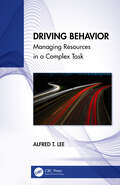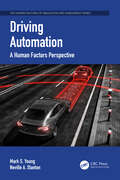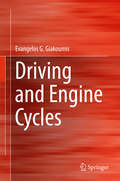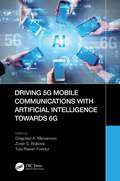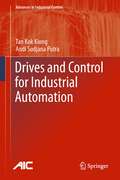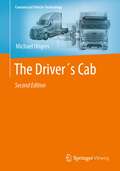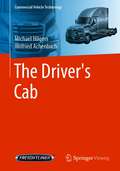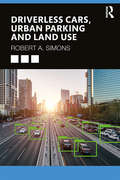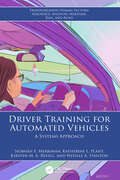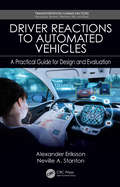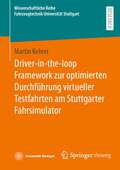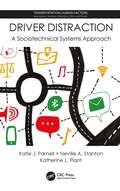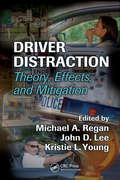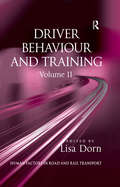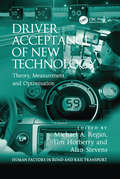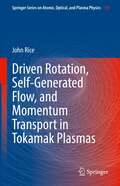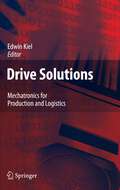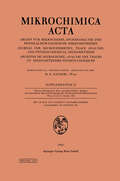- Table View
- List View
Driving Behavior: Managing Resources in a Complex Task
by Alfred T. LeeIn the U.S., drivers over the age of 65 now account for nearly 20% of licensed drivers. This number will increase by 25% to nearly 70 million by the year 2030. Some of these older drivers may not be capable of operating their vehicles safely in all conditions. The book investigates the key aspects of driving tasks and their relation to the sensory, perceptual, motor, and cognitive processes. Effects on driving performance, including aging, are described with a view toward improving future vehicle and road design as well as driver training and evaluation. This title: Presents a comprehensive, quantitative analysis of human physical and mental processes to driving behavior. Showcases recent review and analysis of driver, vehicle, and road environment design factors. Discusses the fundamentals of driving behavior in vehicle control and guidance, collision avoidance, and hazard perception. Examines the effects of design issues on vehicles and road environments. Highlights specific quantifiable attributes of physical and mental functions related to driving approaches. Written for professionals in diverse fields including ergonomics, health and safety, human factors, transportation engineering, and automotive engineering, this book is the essential guide to driving practices and habits. Its appeal will extend to those involved in vehicle design, roadway environments, driver training, and regulatory agencies.
Driving Automation: A Human Factors Perspective (The Human Factors, Simulation and Performance Assessment Series)
by Mark S. Young Neville A. StantonThe technology behind self-driving cars is being heavily promulgated as the solution to a variety of transport problems including safety, congestion, and impact on the environment. This text examines the key role that human factors plays in driving forward future vehicle automation in a way that realizes the benefits while avoiding the pitfalls. Driving Automation: A Human Factors Perspective addresses a range of issues related to vehicle automation beyond the 'can we' to 'how should we'. It covers important topics including mental workload and malleable attentional resources theory, effects of automation on driver performance, in-vehicle interface design, driver monitoring, eco-driving, responses to automation failure, and human-centred automation. The text will be useful for graduate students and professionals in diverse areas such as ergonomics/human factors, automobile engineering, industrial engineering, mechanical engineering, and health and safety.
Driving Automation: A Human Factors Perspective (The Human Factors, Simulation and Performance Assessment Series)
by Mark S. Young Neville A. StantonThe technology behind self-driving cars is being heavily promulgated as the solution to a variety of transport problems including safety, congestion, and impact on the environment. This text examines the key role that human factors plays in driving forward future vehicle automation in a way that realizes the benefits while avoiding the pitfalls. Driving Automation: A Human Factors Perspective addresses a range of issues related to vehicle automation beyond the 'can we' to 'how should we'. It covers important topics including mental workload and malleable attentional resources theory, effects of automation on driver performance, in-vehicle interface design, driver monitoring, eco-driving, responses to automation failure, and human-centred automation. The text will be useful for graduate students and professionals in diverse areas such as ergonomics/human factors, automobile engineering, industrial engineering, mechanical engineering, and health and safety.
Driving and Engine Cycles
by Evangelos G. GiakoumisThis book presents in detail the most important driving and engine cycles used for the certification and testing of new vehicles and engines around the world. It covers chassis and engine-dynamometer cycles for passenger cars, light-duty vans, heavy-duty engines, non-road engines and motorcycles, offering detailed historical information and critical review. The book also provides detailed examples from SI and diesel engines and vehicles operating during various cycles, with a focus on how the engine behaves during transients and how this is reflected in emitted pollutants, CO2 and after-treatment systems operation. It describes the measurement methods for the testing of new vehicles and essential information on the procedure for creating a driving cycle. Lastly, it presents detailed technical specifications on the most important chassis-dynamometer cycles around the world, together with a direct comparison of those cycles.
Driving 5G Mobile Communications with Artificial Intelligence towards 6G
by Dragorad A. Milovanovic Zoran S. Bojkovic Tulsi Pawan FowdurDriving 5G Mobile Communications with Artificial Intelligence towards 6G presents current work and directions of continuously innovation and development in multimedia communications with a focus on services and users. The fifth generation of mobile wireless networks achieved the first deployment by 2020, completed the first phase of evolution in 2022, and started transition phase of 5G-Advanced toward the sixth generation. Perhaps one of the most important innovations brought by 5G is the platform-approach to connectivity, i.e., a single standard that can adapt to the heterogeneous connectivity requirements of vastly different use cases. 5G networks contain a list of different requirements, standardized technical specifications and a range of implementation options with spectral efficiency, latency, and reliability as primary performance metrics. Towards 6G, machine learning (ML) and artificial intelligence (AI) methods have recently proposed new approaches to modeling, designing, optimizing and implementing systems. They are now matured technologies that improve many research fields significantly. The area of wireless multimedia communications has developed immensely, generating a large number of concepts, ideas, technical specifications, mobile standards, patents, and articles. Identifying the basic ideas and their complex interconnections becomes increasingly important. The book is divided into three major parts, with each part containing four or five chapters: Advanced 5G communication Machine learning-based communication and network automation Artificial Intelligence towards 6G The first part discusses three main scenarios and standard specification of 5G use cases (eMBB, URLLC, mMTC), vehicular systems beyond 5G, and efficient edge architecture on NFV infrastructure. In the second part, different AI/ML-based methodologies and open research challenges are presented in introducing 5G-AIoT artificial intelligence of things, scheduling in 5G/6G communication systems, application of DL techniques to modulation, detection, and channel coding as well as 5G Open Source tools for experimentations and testing. The third part paved the way to deployment scenarios for different innovative services including technologies and applications of 5G/6G intelligent connectivity, AI-assisted eXtended Reality, integrated 5G-IoT architecture in next-generation Smart Grid, privacy requirements in a hyper-connected world, and evaluation of representative 6G use cases and technology trends. The book is written by field experts from Europe and Mauritius who introduce a blend of scuentific and engineering concepts covering this emerging wireless communication era. It is a very good reference book for telecom professionals, engineers, and practitioner in various 5G vertical domains and, finally, a basis for student courses in 5G/6G wireless systems.
Driving 5G Mobile Communications with Artificial Intelligence towards 6G
by Dragorad A. Milovanovic Zoran S. Bojkovic Tulsi Pawan FowdurDriving 5G Mobile Communications with Artificial Intelligence towards 6G presents current work and directions of continuously innovation and development in multimedia communications with a focus on services and users. The fifth generation of mobile wireless networks achieved the first deployment by 2020, completed the first phase of evolution in 2022, and started transition phase of 5G-Advanced toward the sixth generation. Perhaps one of the most important innovations brought by 5G is the platform-approach to connectivity, i.e., a single standard that can adapt to the heterogeneous connectivity requirements of vastly different use cases. 5G networks contain a list of different requirements, standardized technical specifications and a range of implementation options with spectral efficiency, latency, and reliability as primary performance metrics. Towards 6G, machine learning (ML) and artificial intelligence (AI) methods have recently proposed new approaches to modeling, designing, optimizing and implementing systems. They are now matured technologies that improve many research fields significantly. The area of wireless multimedia communications has developed immensely, generating a large number of concepts, ideas, technical specifications, mobile standards, patents, and articles. Identifying the basic ideas and their complex interconnections becomes increasingly important. The book is divided into three major parts, with each part containing four or five chapters: Advanced 5G communication Machine learning-based communication and network automation Artificial Intelligence towards 6G The first part discusses three main scenarios and standard specification of 5G use cases (eMBB, URLLC, mMTC), vehicular systems beyond 5G, and efficient edge architecture on NFV infrastructure. In the second part, different AI/ML-based methodologies and open research challenges are presented in introducing 5G-AIoT artificial intelligence of things, scheduling in 5G/6G communication systems, application of DL techniques to modulation, detection, and channel coding as well as 5G Open Source tools for experimentations and testing. The third part paved the way to deployment scenarios for different innovative services including technologies and applications of 5G/6G intelligent connectivity, AI-assisted eXtended Reality, integrated 5G-IoT architecture in next-generation Smart Grid, privacy requirements in a hyper-connected world, and evaluation of representative 6G use cases and technology trends. The book is written by field experts from Europe and Mauritius who introduce a blend of scuentific and engineering concepts covering this emerging wireless communication era. It is a very good reference book for telecom professionals, engineers, and practitioner in various 5G vertical domains and, finally, a basis for student courses in 5G/6G wireless systems.
Drives and Control for Industrial Automation (Advances in Industrial Control)
by Kok Kiong Tan Andi Sudjana PutraDrives and Control for Industrial Automation presents the material necessary for an understanding of servo control in automation. Beginning with a macroscopic view of its subject, treating drives and control as parts of a single system, the book then pursues a detailed discussion of the major components of servo control: sensors, controllers and actuators. Throughout, the mechatronic approach – a synergistic integration of the components – is maintained, in keeping with current practice. The authors’ holistic approach does not preclude the reader from learning in a step-by-step fashion – each chapter contains material that can be studied separately without compromising understanding. Drives are described in several chapters according to the way they are usually classified in industry, each comprised of its actuators and sensors. The controller is discussed alongside. Topics of recent and current interest – piezoelectricity, digital communications and future trends – are detailed in their own chapters.
The Driver´s Cab (Commercial Vehicle Technology)
by Michael HilgersThe aim of this work, consisting of 9 individual, self-contained booklets, is to describe commercial vehicle technology in a way that is clear, concise and illustrative. Compact and easy to understand, it provides an overview of the technology that goes into modern commercial vehicles. Starting from the customer's fundamental requirements, the characteristics and systems that define the design of the vehicles are presented knowledgeably in a series of articles, each of which can be read and studied on their own. In this volume, The Driver's Cab, the vehicle cab is reviewed in simple terms for the layman. The three functions it must support, driving, living and sleeping and the features of the cab equipment provided therefor are presented. Important systems of the driver's cab are discussed in readily understandable terms.
The Driver´s Cab (Commercial Vehicle Technology)
by Michael Hilgers Wilfried AchenbachThe aim of this work, consisting of 9 individual, self-contained booklets, is to describe commercial vehicle technology in a way that is clear, concise and illustrative. Compact and easy to understand, it provides an overview of the technology that goes into modern commercial vehicles. Starting from the customer's fundamental requirements, the characteristics and systems that define the design of the vehicles are presented knowledgeably in a series of articles, each of which can be read and studied on their own. In this volume, The Driver's Cab, the vehicle cab is reviewed in simple terms for the layman. The three functions it must support, driving, living and sleeping and the features of the cab equipment provided therefor are presented. Important systems of the driver's cab are discussed in readily understandable terms.
Driverless Cars, Urban Parking and Land Use
by Robert A. SimonsThe subject of driverless and even ownerless cars has the potential to be the most disruptive technology for real estate, land use, and parking since the invention of the elevator. This book includes new research and economic analysis, plus a thorough review of the current literature to pose and attempt to answer a number of important questions about the effect that driverless vehicles may have on land use in the United States, especially on parking. Simons outlines the history of disruptive technologies in transport and real estate before examining how the predicted changes brought in by the adoption of driverless technologies and decline in car ownership will affect our urban areas. What could we do with all the parking areas in our cities and our homes and institutional buildings that may no longer be required? Can they be sustainably repurposed? Will self-driving cars become like horses, used only by hobbyists for recreation and sport? While the focus is on parking, the book also contains the views of real estate economists, architects, and policymakers and is essential reading for real estate developers and investors, transport economists, planners, politicians, and policymakers who need to consider the implications of a future with more driverless vehicles. Fasten your seat belt: like it or not, driverless cars will begin to change the way we move about our cities within ten years.
Driverless Cars, Urban Parking and Land Use
by Robert A. SimonsThe subject of driverless and even ownerless cars has the potential to be the most disruptive technology for real estate, land use, and parking since the invention of the elevator. This book includes new research and economic analysis, plus a thorough review of the current literature to pose and attempt to answer a number of important questions about the effect that driverless vehicles may have on land use in the United States, especially on parking. Simons outlines the history of disruptive technologies in transport and real estate before examining how the predicted changes brought in by the adoption of driverless technologies and decline in car ownership will affect our urban areas. What could we do with all the parking areas in our cities and our homes and institutional buildings that may no longer be required? Can they be sustainably repurposed? Will self-driving cars become like horses, used only by hobbyists for recreation and sport? While the focus is on parking, the book also contains the views of real estate economists, architects, and policymakers and is essential reading for real estate developers and investors, transport economists, planners, politicians, and policymakers who need to consider the implications of a future with more driverless vehicles. Fasten your seat belt: like it or not, driverless cars will begin to change the way we move about our cities within ten years.
Driver Training for Automated Vehicles: A Systems Approach (ISSN)
by Siobhán E. Merriman Katherine L. Plant Kirsten M. Revell Neville A. StantonSince the introduction of Automated Vehicles (AVs) on roads, there have been a number of high-profile collisions, which have highlighted significant driver challenges. These include challenges associated with drivers’ trust in the automation, their knowledge and awareness of the AV’s capabilities and limitations and their reduced situation awareness of the road environment and the vehicle. Solutions are needed to overcome these challenges, so that the expected benefits of AVs can be realised.Driver Training for Automated Vehicles: A Systems Approach identifies the training requirements for drivers of AVs and takes a systematic approach to design, develop, implement and evaluate a comprehensive training package to address these requirements. This book explores how training can overcome the driver challenges associated with AVs by improving drivers’ mental models, trust in automation, decisions and behaviour when activating a Level 4 AV. It presents a systematic approach to the training lifecycle, by first presenting the current state of research into AVs, identifying the challenges and training requirements for drivers of AVs, and then developing and evaluating a training programme to achieve these requirements. This fascinating title highlights the need for drivers to undergo training for AVs, and takes us a step closer to this need. It walks readers through a systematic, four-step process and provides practical guidance to develop and evaluate an effective training programme. The reader will develop a thorough understanding of the current driver challenges with AVs and the methods and systems to mitigate them through current knowledge and research.This book is an ideal read for practitioners, designers and academics with a professional or research interest in AVs. Its appeal extends to those in the fields of automotive design, Systems Engineering, Human Factors and education and training.
Driver Training for Automated Vehicles: A Systems Approach (ISSN)
by Siobhán E. Merriman Katherine L. Plant Kirsten M. Revell Neville A. StantonSince the introduction of Automated Vehicles (AVs) on roads, there have been a number of high-profile collisions, which have highlighted significant driver challenges. These include challenges associated with drivers’ trust in the automation, their knowledge and awareness of the AV’s capabilities and limitations and their reduced situation awareness of the road environment and the vehicle. Solutions are needed to overcome these challenges, so that the expected benefits of AVs can be realised.Driver Training for Automated Vehicles: A Systems Approach identifies the training requirements for drivers of AVs and takes a systematic approach to design, develop, implement and evaluate a comprehensive training package to address these requirements. This book explores how training can overcome the driver challenges associated with AVs by improving drivers’ mental models, trust in automation, decisions and behaviour when activating a Level 4 AV. It presents a systematic approach to the training lifecycle, by first presenting the current state of research into AVs, identifying the challenges and training requirements for drivers of AVs, and then developing and evaluating a training programme to achieve these requirements. This fascinating title highlights the need for drivers to undergo training for AVs, and takes us a step closer to this need. It walks readers through a systematic, four-step process and provides practical guidance to develop and evaluate an effective training programme. The reader will develop a thorough understanding of the current driver challenges with AVs and the methods and systems to mitigate them through current knowledge and research.This book is an ideal read for practitioners, designers and academics with a professional or research interest in AVs. Its appeal extends to those in the fields of automotive design, Systems Engineering, Human Factors and education and training.
Driver Reactions to Automated Vehicles: A Practical Guide for Design and Evaluation (Transportation Human Factors)
by Alexander Eriksson Neville A. StantonDriver Reactions to Automated Vehicles focuses on the design and evaluation of the handover to and from driver and the automobile. The authors present evidence from studies in driving simulators and on the open roads to show that handover times are much longer than anticipated by previous research. In the course of the studies, Eriksson and Stanton develop compelling evidence to support the use of driving simulators for the study of handovers. They also develop guidelines for the design of handover strategies and show how this improves driver takeover of vehicle control. Features Provides a history of automobile automation Offers a contemporary analysis of the state of automobile automation Includes novel approaches in examining driver-automation interaction Presents studies of automation in driving simulators Includes on-road studies of driver automation Covers guidelines for design of vehicle automation
Driver Reactions to Automated Vehicles: A Practical Guide for Design and Evaluation (Transportation Human Factors)
by Alexander Eriksson Neville A. StantonDriver Reactions to Automated Vehicles focuses on the design and evaluation of the handover to and from driver and the automobile. The authors present evidence from studies in driving simulators and on the open roads to show that handover times are much longer than anticipated by previous research. In the course of the studies, Eriksson and Stanton develop compelling evidence to support the use of driving simulators for the study of handovers. They also develop guidelines for the design of handover strategies and show how this improves driver takeover of vehicle control. Features Provides a history of automobile automation Offers a contemporary analysis of the state of automobile automation Includes novel approaches in examining driver-automation interaction Presents studies of automation in driving simulators Includes on-road studies of driver automation Covers guidelines for design of vehicle automation
Driver-in-the-loop Framework zur optimierten Durchführung virtueller Testfahrten am Stuttgarter Fahrsimulator (Wissenschaftliche Reihe Fahrzeugtechnik Universität Stuttgart)
by Martin KehrerDie Nutzung der Driver-in-the-Loop-Simulation zur virtuellen Entwicklung und Erprobung erfordert ein Software-Framework. Dieses muss zum einen die Erzielung repräsentativer Ergebnisse erlauben und zum anderen die Integration sowohl von Konzeptideen als auch prototypischer oder bestehender Systeme zulassen. Martin Kehrer weist für das Framework eine Simulationsgüte nach, die eine ausreichende Immersion des Fahrers erzielt. Maßgeblich hierfür ist die sogenannte Simulator Sickness, welche ein Index für eine mangelnde Immersion ist. Daneben bedingt die Erprobung neuer Fahrzeugsysteme die Bereitstellung einer ausreichenden Menge an Umgebungsdaten.
Driver Distraction: A Sociotechnical Systems Approach (Transportation Human Factors)
by Katie J. Parnell Neville A. Stanton Katherine L. PlantDriver Distraction: A Sociotechnical Systems Approach promotes a sociotechnical systems approach to driver distraction. This perspective focuses on analysis of the whole system, its values, and the interactions between human and technical elements at all organisational levels. The book covers the role that the sociotechnical system plays in the theory, study and mitigation of driver distraction. The book will be of interest to accident and incident investigation researchers and practitioners. Provides a review of the current state of driver distraction research Describes the development, application, and validation of a novel model of driver distraction that accounts for the sociotechnical system Discusses a new, systems-based, driver distraction definition Explains AcciMap analysis of the current legislation on driver distraction from technological devices Offers novel approaches to understanding why driver distraction occurs Presents a extensive framework of the causal factors that lead to distraction informed by drivers
Driver Distraction: A Sociotechnical Systems Approach (Transportation Human Factors)
by Katie J. Parnell Neville A. Stanton Katherine L. PlantDriver Distraction: A Sociotechnical Systems Approach promotes a sociotechnical systems approach to driver distraction. This perspective focuses on analysis of the whole system, its values, and the interactions between human and technical elements at all organisational levels. The book covers the role that the sociotechnical system plays in the theory, study and mitigation of driver distraction. The book will be of interest to accident and incident investigation researchers and practitioners. Provides a review of the current state of driver distraction research Describes the development, application, and validation of a novel model of driver distraction that accounts for the sociotechnical system Discusses a new, systems-based, driver distraction definition Explains AcciMap analysis of the current legislation on driver distraction from technological devices Offers novel approaches to understanding why driver distraction occurs Presents a extensive framework of the causal factors that lead to distraction informed by drivers
Driver Distraction: Theory, Effects, and Mitigation
by Kristie Young Michael A. Regan John D. LeeA Practical Resource for Understanding, Preventing, and Managing Driver Distraction It is estimated that up to 23 percent of crashes and near-crashes are caused by driver distraction, and these figures will likely increase as more and more distractions, both inside and outside the vehicle, compete for driver attention. Driver Distraction: Theory, E
Driver Behaviour and Training: Volume 2
by Lisa DornResearch on driver behaviour over the past two decades has clearly demonstrated that the goals and motivations a driver brings to the driving task are important determinants for driver behaviour. The importance of this work is underlined by statistics: WHO figures show that road accidents are predicted to be the number three cause of death and injury by 2020 (currently more than 20 million deaths and injuries p.a.). The objective of this second edition, and of the conference on which it is based, is to describe and discuss recent advances in the study of driving behaviour and driver training. It bridges the gap between practitioners in road safety, and theoreticians investigating driving behaviour, from a number of different perspectives and related disciplines. A major focus is to consider how driver training needs to be adapted, to take into account driver characteristics, goals and motivations, in order to raise awareness of how these may contribute to unsafe driving behaviour, and to go on to promote the development of driver training courses that considers all the skills that are essential for road safety. As well as setting out new approaches to driver training methodology based on many years of empirical research on driver behaviour, the contributing road safety researchers and professionals consider the impact of human factors in the design of driver training as well as the traditional skills-based approach. Readership includes road safety researchers from a variety of different academic backgrounds, senior practitioners in the field of driver training from regulatory authorities and professional driver training organizations such as the police service, and private and public sector personnel who are concerned with improving road safety.
Driver Behaviour and Training: Volume 2
by Lisa DornResearch on driver behaviour over the past two decades has clearly demonstrated that the goals and motivations a driver brings to the driving task are important determinants for driver behaviour. The importance of this work is underlined by statistics: WHO figures show that road accidents are predicted to be the number three cause of death and injury by 2020 (currently more than 20 million deaths and injuries p.a.). The objective of this second edition, and of the conference on which it is based, is to describe and discuss recent advances in the study of driving behaviour and driver training. It bridges the gap between practitioners in road safety, and theoreticians investigating driving behaviour, from a number of different perspectives and related disciplines. A major focus is to consider how driver training needs to be adapted, to take into account driver characteristics, goals and motivations, in order to raise awareness of how these may contribute to unsafe driving behaviour, and to go on to promote the development of driver training courses that considers all the skills that are essential for road safety. As well as setting out new approaches to driver training methodology based on many years of empirical research on driver behaviour, the contributing road safety researchers and professionals consider the impact of human factors in the design of driver training as well as the traditional skills-based approach. Readership includes road safety researchers from a variety of different academic backgrounds, senior practitioners in the field of driver training from regulatory authorities and professional driver training organizations such as the police service, and private and public sector personnel who are concerned with improving road safety.
Driver Acceptance of New Technology: Theory, Measurement and Optimisation (Human Factors in Road and Rail Transport)
by Tim Horberry Michael A. Regan Alan StevensAcceptance of new technology and systems by drivers is an important area of concern to governments, automotive manufacturers and equipment suppliers, especially technology that has significant potential to enhance safety. To be acceptable, new technology must be useful and satisfying to use. If not, drivers will not want to have it, in which case it will never achieve the intended safety benefit. Even if they have the technology, drivers may not use it if it is deemed unacceptable, or may not use it in the manner intended by the designer. At worst, they may seek to disable it. This book brings into a single edited volume the accumulating body of thinking and research on driver and operator acceptance of new technology. Bringing together contributions from international experts from around the world, the editors have shaped a book that covers the theory behind acceptance, how it can be measured and how it can be improved. Case studies are presented that provide data on driver acceptance of a wide range of new and emerging vehicle technology. Although driver acceptance is the central focus of this book, acceptance of new technology by operators in other domains, and across cultures, is also investigated. Similarly, perspectives are derived from domains such as human computer interaction, where user acceptance has long been regarded as a key driver of product success. This book comes at a critical time in the history of the modern motor vehicle, as the number of new technologies entering the modern vehicle cockpit rapidly escalates. The goal of this book is to inspire further research and development of new vehicle technology to optimise user acceptance of it; and, in doing so, to maximise its potential to be useful, satisfying to use and able to save human life.
Driven Rotation, Self-Generated Flow, and Momentum Transport in Tokamak Plasmas (Springer Series on Atomic, Optical, and Plasma Physics #119)
by John RiceThis book provides a comprehensive look at the state of the art of externally driven and self-generated rotation as well as momentum transport in tokamak plasmas. In addition to recent developments, the book includes a review of rotation measurement techniques, measurements of directly and indirectly driven rotation, momentum sinks, self-generated flow, and momentum transport. These results are presented alongside summaries of prevailing theory and are compared to predictions, bringing together both experimental and theoretical perspectives for a broad look at the field. Both researchers and graduate students in the field of plasma physics will find this book to be a useful reference. Although there is an emphasis on tokamaks, a number of the concepts are also relevant to other configurations.
Drive Solutions: Mechatronics for Production and Logistics
by E. Kiel Edwin KielHighly automated production and logistics facilities require mechatronic drive solutions. This book describes in which way the industrial production and logistics work and shows the structure of the drive solutions required for this purpose. The functionality of the mechanical and electronic elements of a drive system is described, and their basic dimensioning principles are explained. The authors also outline the engineering, reliability, and important aspects of the life cycle.
